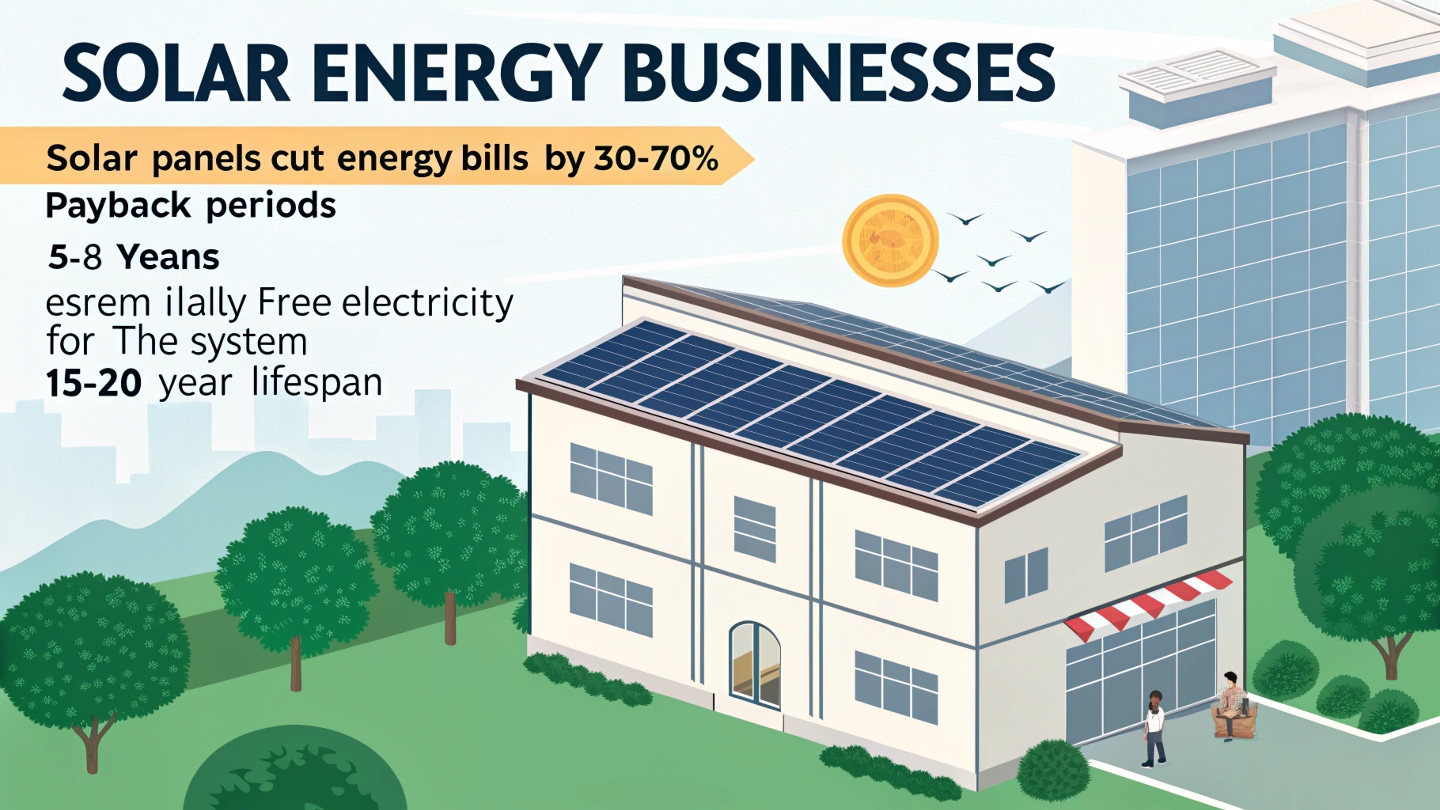Stigande elräkningar skadar dina vinster. Strömavbrott stör driften. Hållbarhetsmål känns utom räckhåll. Solenergi kan lösa dessa problem.
Solenergi minskar företagets elkostnader med 30-70%, Ger backup -ström under avbrott, och hjälper till att uppfylla ESG -mål med rena, förnybar energi. System betalar vanligtvis för sig själva i 5-8 år.

Många företagare tvekar att byta till solenergi. De oroar sig för kostnader, Installationsproblem, och om det verkligen kommer att fungera. Let me show you why these concerns shouldn’t stop you.
Hur mycket kan solenergi verkligen rädda ditt företag?
Elräkningar fortsätter att klättra. Solpaneler kan frysa dessa kostnader i årtionden. Besparingarna kan överraska dig.
Kommersiella solsystem minskar vanligtvis energiräkningar med 30-70%, med återbetalningsperioder av 5-8 år. Därefter, you get essentially free electricity for the system’s remaining 15-20 årslivslängd.

Let’s break down the savings:
| Systemstorlek | Årliga besparingar | Återbetalningsperiod | 25-Årsbesparingar |
|---|---|---|---|
| 50 kW | $15,000 | 6 år | $375,000 |
| 100 kW | $30,000 | 5.5 år | $750,000 |
| 500 kW | $150,000 | 5 år | $3,750,000 |
Dessa siffror antar aktuella elpriser. Eftersom verktygspriserna vanligtvis stiger 3-5% årlig, Dina faktiska besparingar kommer sannolikt att vara högre. Solpaneler ökar också fastighetsvärdet utan att höja fastighetsskatter i de flesta områden.
What’s the Best Solar Solution for Different Business Types?
Inte alla företag använder energi på samma sätt. En butik fungerar annorlunda än en fabrik. Solsystem bör matcha dina specifika behov.
Den perfekta sollösningen beror på dina energianvändningsmönster, takutrymme, och driftstimmar. De flesta företag väljer mellan nätet, utanför nätet, eller hybridsystem.

Here’s how solar works for different businesses:
Tillverkningsanläggningar
- Hög energianvändning på dagen
- Stort takutrymme tillgängligt
- Bäst med system på nätet för att kompensera toppanvändningen
Kontorsbyggnader
- Energianvändning mestadels 9-5
- Kan para ihop med batterilagring
- Perfekt för fakturering av fakturering
Jordbruksverksamhet
- Ofta på avlägsna platser
- Behöver pålitlig kraft utanför nätet
- Sol + lagring förhindrar grödor
Butiker
- Energianvändning hela dagen
- Begränsat takutrymme
- Paneler med hög effektivitet fungerar bäst
Hur väljer du rätt solleverantör?
Inte alla solföretag levererar lika kvalitet. Vissa klippta hörn som kostar dig senare. Rätt partner gör hela skillnaden.
Välj en solleverantör med beprövad erfarenhet, kvalitetsutrustning, och omfattande garantier. Leta efter tillverkare av Tier-1-paneler och minst 10-åriga utförandegarantier.

Kriterier:
Utrustningskvalitet
- Tier-1 solpaneler (Lång, Jinko, Trina)
- Inverterare med >98% effektivitet
- 25+ års prestationsgarantier
Företagets tillförlitlighet
- 5+ år i affärer
- Lokala serviceteam
- Positiva kundrecensioner
Serviceerbjudanden
- Anpassad systemdesign
- Finansieringsalternativ
- Pågående underhåll
Undvik företag som bara pratar om pris. Det billigaste systemet blir ofta det dyraste över tiden på grund av dålig prestanda eller tidigt misslyckande.
Vilka finansieringsalternativ gör Solar överkomliga?
I förväg kostar oroa många företagare. But you don’t need to pay everything at once. Flera alternativ finns.
Företag kan köpa solsystem direkt, använda sollån, eller välja Avtal om kraftköp (energiköpsavtal) med $0 i förväg kostnader Medan du fortfarande sparar pengar.

Jämför alternativen:
| Finansieringsmetod | I förväg | Som äger system | Skatteförmåner | Långtidsbesparingar |
|---|---|---|---|---|
| Kontantköp | 100% | Du | Full | Högsta |
| Sollån | 10-20% | Du | Full | Hög |
| PPA | $0 | Leverantör | Ingen | Måttlig |
| Hyra | $0 | Leverantör | Ingen | Lägre |
Många företag kvalificerar sig för:
- 30% federal skattekredit
- Accelererad avskrivning
- Lokala nytta rabatter
Dessa kan sänka nettokostnaderna med 40-50%.
Slutsats
Solenergi erbjuder företag betydande besparingar, energioberoende, och hållbarhetsfördelar. Med rätt system och leverantör, omkopplaren är enklare än de flesta tror.
